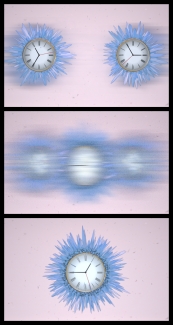Dynamical phase transitions in the quantum world are wildly noisy and chaotic. They don’t look anything like the phase transitions we observe in our everyday world. In Colorado, we see phase transitions caused by temperature changes all the time: snow banks melting in the spring, water boiling on the stove, slick spots on the sidewalk after the first freeze. Quantum phase transitions happen, too, but not because of temperature changes. Instead, they occur as a kind of quantum “metamorphosis” when a system at zero temperature shifts between completely distinct forms.
For instance, one kind of quantum phase transition takes place when a researcher uses lasers to force atoms from a Bose-Einstein condensate (BEC) inside a “crystal” of light, where the atoms solidify into a lattice pattern. Because the ground state arrangement of the atoms has totally changed from the indistinct blur of a BEC to a regular array inside the light crystal, the physical manifestation of the atoms is completely different.
We now know that quantum phase transitions also occur in dynamical systems, thanks to the Holland group. Dynamical systems are systems that can be a long way from equilibrium, like atomic clocks clocks that are always evolving in time, or superradiant lasers that have photons continuously moving in and out of them. Not surprisingly, all sorts of things happen in such dynamical systems when they change their quantum phase. The new understanding of dynamical quantum phase transitions was gained during the Holland group’s theoretical investigation of the quantum aspects of classical synchronization.
Classical synchronization theory explains why fireflies suddenly start emitting light simultaneously, crickets spontaneously sing in unison, metronomes or pendulum clocks synchronize their ticking (if they’re physically connected), or why audiences clap in unison after a minute or two. To study the effects of quantum synchronization as compared to ordinary, everyday synchronization, the Holland group looked at what would happen if two atomic clocks containing identical ensembles of atoms moved close enough to one another to merge into a single, larger atomic clock.
The group discovered that things got really interesting when the clocks moved very close together. Suddenly, it was as if every atom in both clocks was trying to decide, “Should I be in a separate clock or in one clock?” The quantum noise from this process went off scale! The clocks, which had been accurate, with nice sharp, narrow hands, became so noisy and fuzzy that it was impossible to determine the exact time. The clocks had moved into the region of “quantum criticality.” And in the quantum criticality region, the uncertainty inherent in the laws of quantum mechanics is in full play.
Interestingly, when the two clocks finally “decided” to become a single, larger clock, everything quickly settled back down. The hands on the new clock became narrow and sharp as soon as the quantum phase transition was complete. The new, stable quantum phase was a larger atomic clock containing a completely restructured—and synchronized— ensemble of atoms.
The researchers responsible for this new understanding of quantum synchronization during a dynamical phase transition include graduate students Minghui Xu and Dave Tieri, former graduate student Elizabeth Fine, as well as Fellows James Thompson and Murray Holland.
Their work promises to impact research well beyond physics as quantum synchronization is thought to play important roles in brain activity as well as in photosynthetic light harvesting and energy transfer. Because it is also involved in the transition between superconductivity and Mott-insulating behavior in copper-containing metals, quantum synchronization may be an important factor in the design of advanced electronic devices.–Julie Phillips



 The Physics Frontiers Centers (PFC) program supports university-based centers and institutes where the collective efforts of a larger group of individuals can enable transformational advances in the most promising research areas. The program is designed to foster major breakthroughs at the intellectual frontiers of physics by providing needed resources such as combinations of talents, skills, disciplines, and/or specialized infrastructure, not usually available to individual investigators or small groups, in an environment in which the collective efforts of the larger group can be shown to be seminal to promoting significant progress in the science and the education of students. PFCs also include creative, substantive activities aimed at enhancing education, broadening participation of traditionally underrepresented groups, and outreach to the scientific community and general public.
The Physics Frontiers Centers (PFC) program supports university-based centers and institutes where the collective efforts of a larger group of individuals can enable transformational advances in the most promising research areas. The program is designed to foster major breakthroughs at the intellectual frontiers of physics by providing needed resources such as combinations of talents, skills, disciplines, and/or specialized infrastructure, not usually available to individual investigators or small groups, in an environment in which the collective efforts of the larger group can be shown to be seminal to promoting significant progress in the science and the education of students. PFCs also include creative, substantive activities aimed at enhancing education, broadening participation of traditionally underrepresented groups, and outreach to the scientific community and general public.